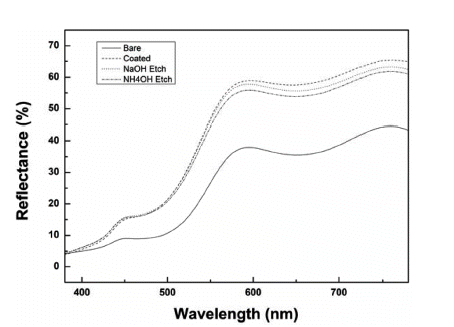- [Korean]
- Study of Color Evolution by Silica Coating and Etching based Morphological Control of α-FeOOH
-
NaRi Lee, Ri Yu, YooJin Kim
-
J Korean Powder Metall Inst. 2018;25(5):379-383. Published online October 1, 2018
-
DOI: https://doi.org/10.4150/KPMI.2018.25.5.379
-
-
830
View
-
3
Download
-
1
Citations
-
 Abstract Abstract
 PDF PDF
Silica is used in shell materials to minimize oxidation and aggregation of nanoparticles. Particularly, porous silica has gained attention because of its performance in adsorption, catalysis, and medical applications. In this study, to investigate the effect of the density of the silica coating layer on the color of the pigment, we arbitrarily change the structure of a silica layer using an etchant. We use NaOH or NH4OH to etch the silica coating layer. First, we synthesize α-FeOOH for a length of 400 nm and coat it with TEOS to fabricate particles with a 50 nm coating layer. The coating thickness is then adjusted to 30–40 nm by etching the silica layer for 5 h. Four different shapes of α-FeOOH with different colors are measured using UV–vis light. From the color changes of the four different shapes of α-FeOOH features during coating or etching, the L* value is observed to increase and brighten the overall color, and the b* value increases to impart a clear yellow color to the pigment. The brightest yellow color was that coated with silica; if the sample is etched with NaOH or NH4OH, the b* value can be controlled to study the yellow colors. -
Citations
Citations to this article as recorded by  - Trend of Ceramic Nano Pigments
Ri Yu, YooJin Kim
Ceramist.2019; 22(3): 256. CrossRef
- [Korean]
- Preparation and Characterization of Visible Light-Sensitive N-doped TiO2 Using a Sol-gel Method
-
NaRi Lee, Ri Yu, Tae Kwan Kim, Jae-Hwan Pee, YooJin Kim
-
J Korean Powder Metall Inst. 2017;24(6):477-482. Published online December 1, 2017
-
DOI: https://doi.org/10.4150/KPMI.2017.24.6.477
-
-
 Abstract Abstract
 PDF PDF
Nitrogen-doped titanium dioxide (N-doped TiO2) is attracting continuously increasing attention as a material for environmental photocatalysis. The N-atoms can occupy both interstitial and substitutional positions in the solid, with some evidence of a preference for interstitial sites. In this study, N-doped TiO2 is prepared by the sol–gel method using NH4OH and NH4Cl as N ion doping agents, and the physical and photocatalytic properties with changes in the synthesis temperature and amount of agent are analyzed. The photocatalytic activities of the N-doped TiO2 samples are evaluated based on the decomposition of methylene blue (MB) under visible-light irradiation. The addition of 5 wt% NH4Cl produces the best physical properties. As per the UV-vis analysis results, the N-doped TiO2 exhibits a higher visible-light activity than the undoped TiO2. The wavelength of the N-doped TiO2 shifts to the visible-light region up to 412 nm. In addition, this sample shows MB removal of approximately 81%, with the whiteness increasing to +97 when the synthesis temperature is 600oC. The coloration and phase structure of the N-doped TiO2 are characterized in detail using UV-vis, CIE Lab color parameter measurements, and powder X-ray diffraction (XRD).
|



